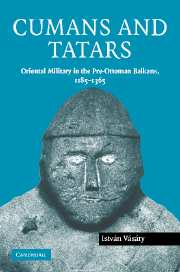Book contents
- Frontmatter
- Contents
- Preface
- 1 Introduction
- 2 Cumans and the Second Bulgarian Empire
- 3 Cumans in the Balkans before the Tatar conquest, 1241
- 4 The first period of Tatar influence in the Balkans, 1242–1282
- 5 The heyday of Tatar influence in the Balkans, 1280–1301
- 6 Cumans and Tatars on the Serbian scene
- 7 Cumans in Byzantine service after the Tatar conquest, 1242–1333
- 8 The Tatars fade away from Bulgaria and Byzantium, 1320–1354
- 9 The emergence of two Romanian principalities in Cumania, 1330, 1364
- Conclusion
- Appendix 1 List of geographical names
- Appendix 2 Chronological table of dynasties
- Appendix 3 Maps
- List of abbreviations
- Bibliography
- Index
Conclusion
Published online by Cambridge University Press: 29 July 2009
- Frontmatter
- Contents
- Preface
- 1 Introduction
- 2 Cumans and the Second Bulgarian Empire
- 3 Cumans in the Balkans before the Tatar conquest, 1241
- 4 The first period of Tatar influence in the Balkans, 1242–1282
- 5 The heyday of Tatar influence in the Balkans, 1280–1301
- 6 Cumans and Tatars on the Serbian scene
- 7 Cumans in Byzantine service after the Tatar conquest, 1242–1333
- 8 The Tatars fade away from Bulgaria and Byzantium, 1320–1354
- 9 The emergence of two Romanian principalities in Cumania, 1330, 1364
- Conclusion
- Appendix 1 List of geographical names
- Appendix 2 Chronological table of dynasties
- Appendix 3 Maps
- List of abbreviations
- Bibliography
- Index
Summary
Many of the results of this investigation have been presented as isolated conclusions, especially when I have summarised sections or chapters of this book. It is now time to offer an overview of the main lessons drawn from the Cumans' and Tatars' presence in the Balkans. The most enduring impact of these nomadic peoples and empires on the history of the Balkans in the twelfth to fourteenth centuries affects three areas; first, political history; secondly, military history, and thirdly, ethnic history.
First, the Cumans' role in the political history of the Balkans was decisive in the period from 1185 to the 1330s. Cumans were the founders of three successive Bulgarian dynasties (the Asenids, the Terterids and the Šišmanids) and of the Wallachian dynasty (the Basarabids). Thus, apart from a few years of interregnum under the illegitimate pretenders Ivaylo (1277–80) and later Smilec (1292–7), all the dynasties of the Second Bulgarian Kingdom were of Cuman origin. They also played a considerable role in the political history of contemporary Byzantium, Hungary, and Serbia, and certain members of Cuman immigrant communities became integral members of the recipient country's elite (cf. Köten's relatives in Hungary, or Syrgiannes/Saronius and his family in Byzantium). The infiltration and rise to power of the immigrant Cuman elites in the Balkanic countries in 1242–1330 proceeded under the control and approval of the Tatar state of the Golden Horde.
- Type
- Chapter
- Information
- Cumans and TatarsOriental Military in the Pre-Ottoman Balkans, 1185–1365, pp. 166 - 167Publisher: Cambridge University PressPrint publication year: 2005

